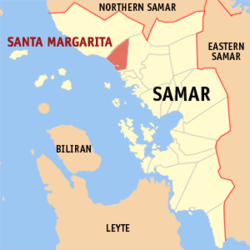Santa Margarita, Samar
| Santa Margarita | |
|---|---|
| Municipality | |
 Map of Samar with Sta. Margarita highlighted | |
.svg.png) Santa Margarita Location within the Philippines | |
| Coordinates: 12°02′N 124°40′E / 12.033°N 124.667°ECoordinates: 12°02′N 124°40′E / 12.033°N 124.667°E | |
| Country | Philippines |
| Region | Eastern Visayas (Region VIII) |
| Province | Samar |
| Congr. district | 1st district of Samar |
| Barangays | 36 |
| Government[1] | |
| • Mayor | Gemma Zosa |
| Area[2] | |
| • Total | 129.12 km2 (49.85 sq mi) |
| Population (2010)[3] | |
| • Total | 24,850 |
| • Density | 190/km2 (500/sq mi) |
| Time zone | PST (UTC+8) |
| ZIP code | 6709 |
| Dialing code | 55 |
| Website |
santamargaritasamar |
Santa Margarita (Waray: Bungto san Magsohong) is a 4fourth class municipality in Samar province, Philippines. According to the 2010 census, it has a population of 24,850 people.[3] It is bounded to the north by the city of Calbayog and bounded to the south by Gandara.
Barangays
Santa Margarita is politically subdivided into 36 barangays.[2]
- Agrupacion
- Arapison
- Avelino
- Bahay
- Balud
- Bana-ao
- Burabod
- Cautod (Pob.)
- Camperito
- Campeig
- Can-ipulan
- Canmoros
- Cinco
- Curry
- Gajo
- Hindang
- Ilo
- Imelda
- Inoraguiao
- Jolacao
- Lambao
- Mabuhay
- Mahayag
- Monbon (Pob.)
- Nabulo
- Napuro
- Palale
- Panabatan
- Panaruan
- Roxas
- Salvacion
- Solsogon
- Sundara
- Cagsumji
- Matayonas
- Napuro II
History
The town use to be a barrio in Calbayog named Magsohong, but on June 29, 1878, the principalía of Magsohong, petitioned the Gobierno Superior to establish Magsohong as an independent pueblo. They argued that Magsohong was four hours away from Calbayog, it already had a casa real of nipa, a church with a techada (roof) of nipa; a convent; an escuela also made of wood and nipa; and had more than 300 tributos. The petition was endorsed by the cura parroco, the Gobernadorcillo as well as the principalía of Calbayog. Fourteen years later, Royal Decree No. 25 dated September 25, 1892 approved the establishment of the pueblo of Magsohong renamed Sta. Margarita. The new pueblo had three visitas: Balud, San Bernardo, and Londara. However, it remained under the parish of Calbayog.
Demographics
| Population census of Santa Margarita | ||
|---|---|---|
| Year | Pop. | ±% p.a. |
| 1990 | 16,878 | — |
| 1995 | 19,146 | +2.39% |
| 2000 | 21,740 | +2.76% |
| 2007 | 23,488 | +1.07% |
| 2010 | 24,850 | +2.07% |
| Source: National Statistics Office[3][4] | ||
Natural attractions
- Arapison Falls
- Baluarte
- Burabod Picnic Grove
- Calvary Hill
- The Oldest Bell
Alimango Festival
July 25 (Alimango Festival) - this dance festival revolves around the courtship between the female alimango (mud crabs found in fishponds) Atabayi and the male Amamakhao. It also depicts the capture of the alimango with the use of the bobo and giant bentol. Dancers, dressed as alimango, flex their hands as if to bite. Snare drums and talutang highlight the fast rhythm of the dance.
References
- ↑ "Municipalities". Quezon City, Philippines: Department of the Interior and Local Government. Retrieved 14 May 2013.
- ↑ 2.0 2.1 "Province: Samar (Western Samar)". PSGC Interactive. Makati City, Philippines: National Statistical Coordination Board. Retrieved 14 May 2013.
- ↑ 3.0 3.1 3.2 "Total Population by Province, City, Municipality and Barangay: as of May 1, 2010". 2010 Census of Population and Housing. National Statistics Office. Retrieved 14 May 2013.
- ↑ "Province of Western Samar". Municipality Population Data. LWUA Research Division. Retrieved 21 August 2013.
External links
- Official Website
- Philippine Standard Geographic Code
- Philippine Census Information
- Local Governance Performance Management System
 |
Calbayog | |
Gandara |  |
| |
||||
| ||||
| | ||||
| Samar Sea | |
Gandara |
| ||||||||||||||